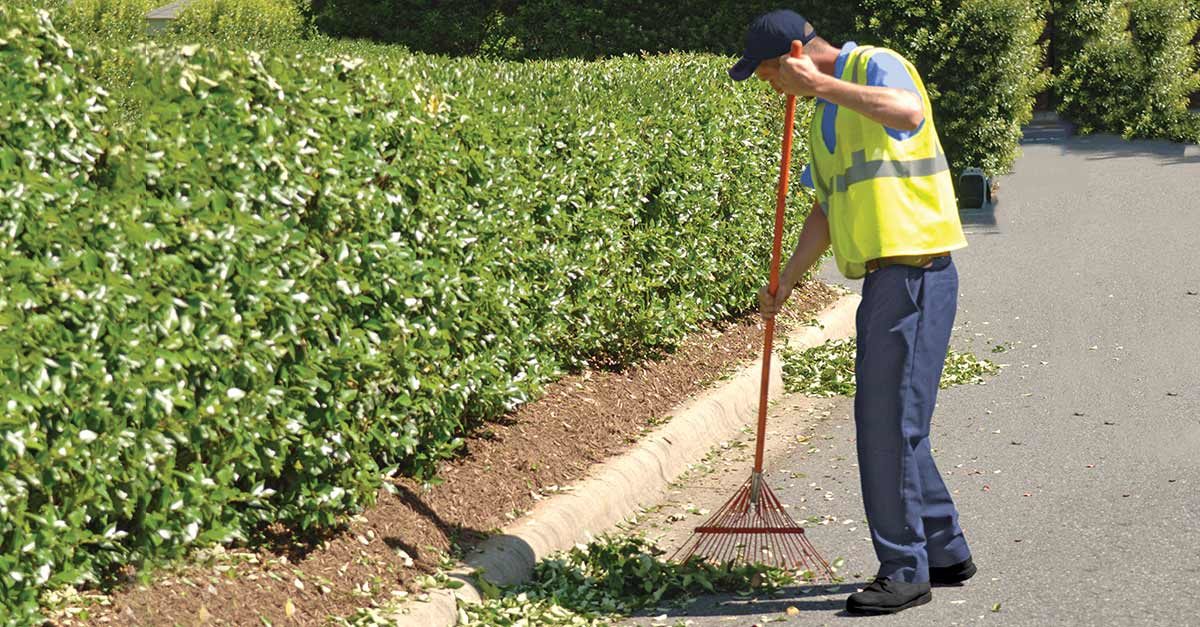Creating a healthy and attractive landscape during the summer can be a challenging task for many facility managers.
With hot and humid temperatures, and storm season at its peak, landscapes are under a high level of stress. While summer weather can be unpredictable, following a few best practices and preparing in advance can ensure your facility’s landscape is well supported all season long.
Creating a Maintenance Plan
Creating a comprehensive maintenance plan that addresses all of your property’s needs is the first—and most important—step in promoting a sustainable landscape. Your maintenance plan should identify high-risk areas, set expectations for the exterior maintenance team, establish a schedule for routine tasks, and identify non-routine needs.
Identify high-risk areas. Facility managers should work with their exterior maintenance staff to identify areas on the property that are at high risk for damage and therefore, require more attention throughout the season. Specifically, you should discuss areas that have experienced flooding, downed trees, or need more irrigation. Completing this step will help decrease the risk of future damage to your property.
Set expectations. Setting expectations is another key component that will help you design a successful maintenance plan. Expectations will vary depending on the type of property you are managing. For example, if you are managing a property where the appearance of the landscape is important to the brand of the business—such as retail centers, hotels, or business parks—your landscape should reflect a minimum of a crisp, clean, and safe environment at all times.
On the other hand, if you’re the facility manager for an industrial park—where the landscape isn’t a reflection of your business—a more minimal service approach can be taken to sustain the landscape. Sharing any vegetation preferences (for example, flowers, trees, grass, etc.) with your landscaping contractor or crew will also help you to stay on the same page.
Plan for routine maintenance. Likewise, establishing when your property will receive routine maintenance, such as mowing, mulching, and trimming, is extremely important for keeping tenants, guests, and residents happy. For example, in a retail environment where tenants don’t typically open before 10 a.m. and close in the late evening hours, your crew should plan to come on site before the stores open. In contrast, for hotels, apartment complexes, or residential communities, routine maintenance should occur during the midday to early evening hours while most tenants or residents are at work.
The frequency of service is equally as important when you’re working on creating a maintenance schedule. Again, how often your property will need service is dependent on the profile of the property. High-profile properties, such as hotels, retail centers, and business parks, need to be maintained consistently and serviced more frequently than manufacturing or industrial properties.
Another factor that influences service frequency is the type of grass you have planted, as certain grasses grow at faster rates and require more frequent watering than others. The same principal holds true for flower selection and other vegetation that you have planted. Asking the distributor or nursery about the watering requirements will help you establish an irrigation schedule. Having a drip irrigation system installed in flowerbeds close to walkways can also help facility managers accurately maintain their beds, as they can take weather conditions into account.
Consider non-routine maintenance. Due to the hot and humid temperatures the summer delivers, watering the grass and other vegetation as close to sunrise as possible will help reduce the risk of water pooling around plants all night or burning off during the heat of the day. And unless you want a muddy landscape, irrigation should never occur on the same day as the grass mowing.
Managers also need to designate a specific time for pest control and fertilizer treatment. From an agronomics perspective, it’s essential that your property receive treatment before summer hits. If pesticides and other weed control substances are applied to vegetation in temperatures above 85 degrees Fahrenheit, it will burn the vegetation.
Prepping for Storms
As with any aspect of facility management, dealing with a storm will go more smoothly when you have a plan in place. Managers should work with their exterior maintenance crew to construct a written storm preparation plan and make sure all relevant employees are familiar with it. The below processes will help you and your crew to ensure preparation runs efficiently, and will reduce the risk of landscape damage, should severe weather arise.
Monitor drainage. To prevent your landscape from potential flooding, managers should work with their exterior maintenance crew to ensure that their drainage is installed properly and kept clean and clear over the course of the summer. Because grass clippings and other debris can make their way into your property’s drainage systems, carrying out a quick check after the grass has been mowed will also help mitigate the risk of flooding.
Trim the landscape. Working with your crew or contractor to ensure that your trees and bushes are properly pruned will prevent further damage to the landscape.
Check for diseased tree branches. This is an instrumental part of storm readiness. Because down branches can pose a great safety risk, your exterior maintenance crew may check for diseased branches every three to five years. However, if you’re located in a region where there’s an abundance of palm trees, your crew will do a quick property check more often.
It’s important to point out there are many types of diseases that affect trees and other vegetation. Leaf discoloration (yellowing of leaves), deformation, and blotches on leaves are the most common signs of a diseased tree. If a facility manager does not work with a landscaping professional and they notice a diseased tree, they should immediately consult an arborist, as it can be tricky to identify the type of disease infecting the tree in addition to the most accurate treatment method.
Summer Storm Cleanup
There are four different phases to post-storm cleanup.
Phase 1: During the first phase, your crew will want to assess the property for any life-threatening issues. These issues include leaning trees, downed power lines, and large broken branches.
Phase 2: The second step focuses on opening up (clearing) areas closest to the facility. Storm debris will suffocate the vegetation, so having your crew clean up as soon as possible is extremely important for the life cycle of your plants. If vegetation isn’t opened up within one to two days, the risk to plant damage is greatly increased. Managers might not see immediate damage to their plants, but it can take up to six months to see long-term effects. Fungus is another issue that plants can experience from storm debris.
Phase 3: The third step in the process is clearing debris from all other locations of the property. These areas include parking lots, maintenance facilities, and all other areas that are not adjacent to the main facility.
Phase 4: The final step in the storm cleanup process is removing the stacked debris from all locations and hauling everything to the dump.
Because the first few steps need to happen almost immediately after a storm, it’s imperative that facility managers educate and work with their crews beforehand to pre-approve storm cleanup methods.
Landscape Redevelopment
Unfortunately, storm damage is inevitable. Storms can cause severe damage to the plants, outdoor furniture, and other landscaping details on your property. To ensure that your landscape is well supported after a storm, facility managers should factor the cost of a reasonable amount of reap into their budgets. If the damage goes beyond what an in-house staff can reasonably fix, property managers might turn to an outside landscaping service to correct the damage. Property managers should ask to see a list of services associated with storm cleanup and costs associated with each.
Keep Your Facility Dry
Monitoring drains and ensuring they are clear is one way to prevent your property from flooding when a storm comes through. However, there are other ways to protect your facility from an overflow of storm water.
- French drains are perforated drains that transport water out of your grounds and into storm drains. The best spots for them are in the lowest elevation areas of your properties.
- Dry wells can contain large amounts of water that surge in during heavy rainfall. The wells allow the water to seep into the soil gradually throughout several days to help avoid massive flooding.
- Sump pumps are often the most effective way to deal with flooded grounds. Check pumps regularly to ensure they are working and moving water away from your property and into waiting storm drains.
- Topsoil and organic mulch can elevate low lying portions of the properties that are prone to flooding.




